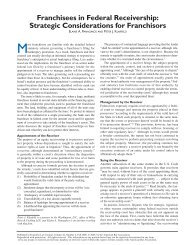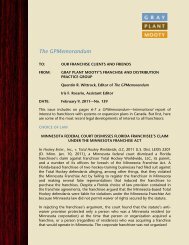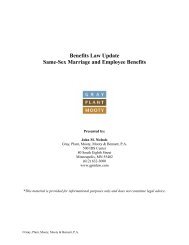Los Angeles Lawyer October 2008 - Gray Plant Mooty
Los Angeles Lawyer October 2008 - Gray Plant Mooty
Los Angeles Lawyer October 2008 - Gray Plant Mooty
Create successful ePaper yourself
Turn your PDF publications into a flip-book with our unique Google optimized e-Paper software.
ficulties and requires short meetings and frequent<br />
breaks in order to participate effectively.<br />
Simple accommodations can make a big<br />
difference in the effectiveness in one’s representation.<br />
In addition to inquiring about any accommodations,<br />
an attorney should be proactive<br />
and do research prior to the first meeting<br />
with a client with a disability. The Internet<br />
makes research quick and easy. A simple<br />
search can reveal typical needs or accommodations<br />
individuals with certain disabilities<br />
may require. However, the attorney must<br />
absorb the cost of accommodating an individual<br />
with a disability and may not pass<br />
those costs on to the client. 3 Researching and<br />
learning about a client’s particular disability<br />
can put parties at ease and allow everyone to<br />
focus on the issues of the case rather than<br />
causing unnecessary anxiety about being insensitive<br />
and alienating a client with a disability.<br />
Physical access accommodations can be<br />
tricky. Not all buildings are accessible to individuals<br />
with disabilities. Building managers or<br />
property owners should be knowledgeable<br />
about whether a building is accessible. When<br />
in doubt about physical accessibility, ask the<br />
building manager. Inquiring whether a structure<br />
is accessible prior to a first meeting with a<br />
client will reveal any issues that may need to<br />
be addressed.<br />
Another step to ensure physical access<br />
for an individual with a disability is to ensure<br />
that any other structure that the client may<br />
visit is accessible. It is not wise to assume that<br />
all offices are ADA compliant and accessible.<br />
It is useful to call ahead in order to ensure a<br />
structure is accessible. It would be embarrassing<br />
and awkward to arrive at an office<br />
building with a client who uses a wheelchair<br />
only to learn that the building does not have<br />
an operating elevator.<br />
Additionally, not all courthouses and<br />
public buildings are accessible. Again, a little<br />
foresight can avoid problems. The attorney<br />
should call ahead and make arrangements.<br />
It may be embarrassing and a waste<br />
of time if an important meeting is organized<br />
to take place in a nonaccessible structure.<br />
Although it is necessary and appropriate to<br />
make inquiries about required accommodations<br />
for individuals with disabilities, any<br />
inquiries should be professional and courteous.<br />
Grandiose gestures of sensitivity are<br />
not necessary. After inquiring about accommodations,<br />
it is not necessary to ask a second<br />
time. The ADA is intended to provide<br />
persons with disabilities equal opportunity<br />
and to eliminate discrimination. 4 Accordingly,<br />
once an inquiry about accommodations<br />
is made, then the client should be treated as<br />
any other person.<br />
Places of public accommodation, such as<br />
law offices, 5 must meet physical specifications<br />
outlined in the ADA to ensure that they<br />
are accessible to individuals with disabilities.<br />
The purpose is to prohibit discrimination<br />
against individuals with disabilities and allow<br />
individuals the ability to enjoy goods and<br />
services at the same level as those individuals<br />
without disabilities. 6 New construction<br />
and structures that existed prior to the passage<br />
of the ADA are subject to accessibility<br />
requirements. 7 The Code of Federal Regulations<br />
(Title 28, Part 36) has detailed illustrations<br />
of appropriate construction to ensure<br />
ADA compliance.<br />
The attorney should consult with the<br />
building’s property owner to ensure a particular<br />
structure is ADA compliant; a tenant<br />
may be responsible for an ADA violation<br />
even without owning the physical structure. 8<br />
There are exceptions to the rules. For example,<br />
if architectural barrier removal is not<br />
readily achievable, the barrier may stay. 9<br />
Barrier removal is readily achievable if it is<br />
easy to accomplish and able to be carried<br />
out without much difficulty or expense. 10<br />
If an office is not accessible and cannot<br />
accommodate a client with a disability, it is<br />
acceptable to arrange to meet at a location that<br />
is ADA compliant. 11 It may be acceptable to<br />
arrange to meet a client at his or her residence;<br />
however, the representation must not<br />
be compromised because of having to meet at<br />
the residence as opposed to an office building.<br />
12 If an office is not accessible for people<br />
with mobility disabilities, steps should be<br />
taken before meeting a client. Including a<br />
question about the necessity for an accommodation<br />
may be added to an intake interview<br />
or form to facilitate a smooth first meeting.<br />
Ensuring Communication<br />
Not all accommodations involve architectural<br />
barriers. Service animals are trained to<br />
perform tasks that assist their owners with<br />
daily living. Service animals are not limited to<br />
seeing-eye dogs. The general public may or<br />
may not be allowed to bring animals to an<br />
office, but it is required that persons with disabilities<br />
be allowed to bring service animals. 13<br />
Often it will be clear whether an animal is a<br />
service animal. However, if it is unclear, a simple<br />
inquiry about whether an animal is a service<br />
animal will suffice.<br />
Even if an office building is ADA compliant,<br />
there are several quick steps to take to<br />
ensure there are no barriers in the structure.<br />
First, a quick sweep of the areas of ingress and<br />
egress can reveal barriers. Boxes or other<br />
articles lying on the floor can cause a doorway<br />
or hallway to become too narrow for<br />
comfortable access by a wheelchair. A meeting<br />
room may have a table that is too large<br />
for a client to navigate. Additionally, a quick<br />
inspection of the bathroom will ensure the<br />
availability of an accessible bathroom.<br />
Many people with disabilities require<br />
attention to medical needs. Some individuals<br />
require the presence of a medical assistant or<br />
nurse. Prior to meeting with an individual<br />
who requires the presence of a medical assistant,<br />
it may be necessary to discuss whether<br />
or not the assistant is required to remain in<br />
the same room as the client at all times.<br />
Sometimes a medical assistant may be able<br />
to remain close but not actually present, so<br />
that attorney-client confidentiality is not disturbed.<br />
In other instances, it may be necessary<br />
for a medical assistant to be constantly<br />
in the presence of an individual. In such a<br />
case, steps should be taken to preserve the<br />
attorney-client confidentiality. Additionally,<br />
if a medical assistant must accompany an<br />
individual to various meetings, calling ahead<br />
of time to ensure there is space for both people<br />
is important.<br />
Businesses, including law offices, must<br />
take steps to ensure that they may communicate<br />
with individuals with disabilities as<br />
effectively as they would with nondisabled<br />
individuals. 14 Effective communication is<br />
vital to fulfill the duty to represent clients<br />
competently. 15<br />
Hearing, visual, and speech disorders can<br />
affect the ability to communicate. It may be<br />
necessary to hire (and absorb the cost of) an<br />
interpreter for in-person meetings or phone<br />
conversations. Phone companies are required<br />
to ensure that individuals with disabilities<br />
have functionally equivalent telecommunication<br />
services. 16<br />
Telecommunication devices for people<br />
who are deaf, hard of hearing, or have speech<br />
impairments can be used with phone lines.<br />
Again, the attorney should simply ask the<br />
individual whether a telecommunication<br />
device or other method of communication is<br />
necessary. Today, many people have access to<br />
Internet-based communication devices. Some<br />
individuals may prefer to use a simple Internet<br />
chatting service rather than a more specific<br />
technology. Use of a particular communication<br />
device or relay service should not cost an<br />
individual with a disability an additional<br />
amount of money.<br />
For persons with visual disabilities, written<br />
documents may not be an appropriate<br />
method of communication. Again, a simple<br />
inquiry about an individual’s preferred<br />
method of receiving communications will<br />
reveal what accommodations are necessary.<br />
It is possible that an individual will have<br />
technology that “reads” printed documents,<br />
or “reads” electronic versions of documents.<br />
Additionally, there are services and devices<br />
that can turn a written document into Braille.<br />
Attention to the little things can make a<br />
big difference. For example, when meeting<br />
with a client who reads lips, the interaction<br />
and communication may run more smoothly<br />
<strong>Los</strong> <strong>Angeles</strong> <strong>Lawyer</strong> <strong>October</strong> <strong>2008</strong> 11







